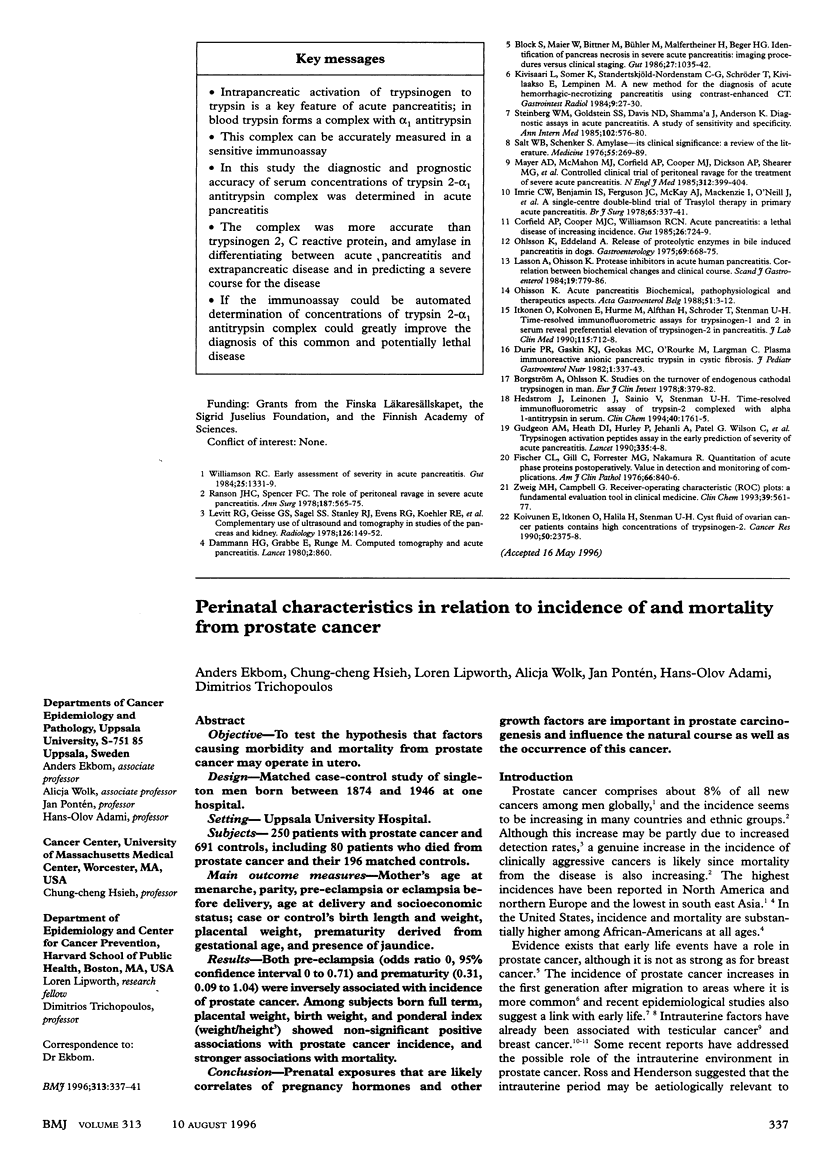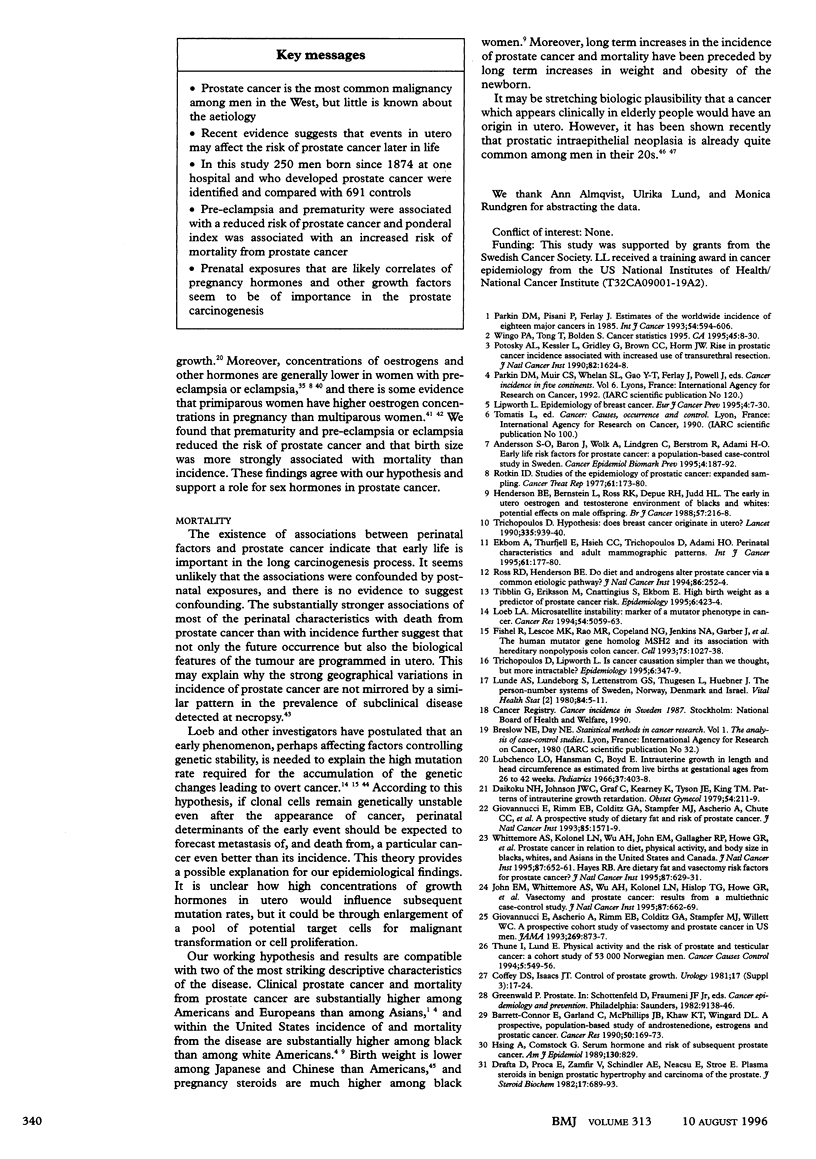Abstract
OBJECTIVE--To test the hypothesis that factors causing morbidity and mortality from prostate cancer may operate in utero. DESIGN--Matched case-control study of singleton men born between 1874 and 1946 at one hospital. SETTING--Uppsala University Hospital. SUBJECTS--250 patients with prostate cancer and 691 controls, including 80 patients who died from prostate cancer and their 196 matched controls. MAIN OUTCOME MEASURES--Mother's age at menarche, parity, pre-eclampsia or eclampsia before delivery, age at delivery and socioeconomic status; case or control's birth length and weight, placental weight, prematurity derived from gestational age, and presence of jaundice. RESULTS--Both pre-eclampsia (odds ratio 0, 95% confidence interval 0 to 0.71) and prematurity (0.31, 0.09 to 1.04) were inversely associated with incidence of prostate cancer. Among subjects born full term, placental weight, birth weight, and ponderal index (weight/height 3) showed non-significant positive associations with prostate cancer incidence, and stronger associations with mortality. CONCLUSION--Prenatal exposures that are likely correlates of pregnancy hormones and other growth factors are important in prostate carcinogenesis and influence the natural course as well as the occurrence of this cancer.
Full text
PDF




Selected References
These references are in PubMed. This may not be the complete list of references from this article.
- Andersson S. O., Adami H. O., Bergström R., Wide L. Serum pituitary and sex steroid hormone levels in the etiology of prostatic cancer--a population-based case-control study. Br J Cancer. 1993 Jul;68(1):97–102. doi: 10.1038/bjc.1993.293. [DOI] [PMC free article] [PubMed] [Google Scholar]
- Andersson S. O., Baron J., Wolk A., Lindgren C., Bergström R., Adami H. O. Early life risk factors for prostate cancer: a population-based case-control study in Sweden. Cancer Epidemiol Biomarkers Prev. 1995 Apr-May;4(3):187–192. [PubMed] [Google Scholar]
- Barrett-Connor E., Garland C., McPhillips J. B., Khaw K. T., Wingard D. L. A prospective, population-based study of androstenedione, estrogens, and prostatic cancer. Cancer Res. 1990 Jan 1;50(1):169–173. [PubMed] [Google Scholar]
- Bernstein L., Depue R. H., Ross R. K., Judd H. L., Pike M. C., Henderson B. E. Higher maternal levels of free estradiol in first compared to second pregnancy: early gestational differences. J Natl Cancer Inst. 1986 Jun;76(6):1035–1039. [PubMed] [Google Scholar]
- Cheville J. C., Bostwick D. G. Postatrophic hyperplasia of the prostate. A histologic mimic of prostatic adenocarcinoma. Am J Surg Pathol. 1995 Sep;19(9):1068–1076. doi: 10.1097/00000478-199509000-00011. [DOI] [PubMed] [Google Scholar]
- Coffey D. S., Isaacs J. T. Control of prostate growth. Urology. 1981 Mar;17(Suppl 3):17–24. [PubMed] [Google Scholar]
- Daikoku N. H., Johnson J. W., Graf C., Kearney K., Tyson J. E., King T. M. Patterns of intrauterine growth retardation. Obstet Gynecol. 1979 Aug;54(2):211–219. [PubMed] [Google Scholar]
- Drafta D., Proca E., Zamfir V., Schindler A. E., Neacşu E., Stroe E. Plasma steroids in benign prostatic hypertrophy and carcinoma of the prostate. J Steroid Biochem. 1982 Dec;17(6):689–693. doi: 10.1016/0022-4731(82)90572-6. [DOI] [PubMed] [Google Scholar]
- Ekbom A., Thurfjell E., Hsieh C. C., Trichopoulos D., Adami H. O. Perinatal characteristics and adult mammographic patterns. Int J Cancer. 1995 Apr 10;61(2):177–180. doi: 10.1002/ijc.2910610206. [DOI] [PubMed] [Google Scholar]
- Fishel R., Lescoe M. K., Rao M. R., Copeland N. G., Jenkins N. A., Garber J., Kane M., Kolodner R. The human mutator gene homolog MSH2 and its association with hereditary nonpolyposis colon cancer. Cell. 1993 Dec 3;75(5):1027–1038. doi: 10.1016/0092-8674(93)90546-3. [DOI] [PubMed] [Google Scholar]
- Gerhard I., Vollmar B., Runnebaum B., Klinga K., Haller U., Kubli F. Weight percentile at birth. II. Prediction by endocrinological and sonographic measurements. Eur J Obstet Gynecol Reprod Biol. 1987 Dec;26(4):313–328. doi: 10.1016/0028-2243(87)90129-8. [DOI] [PubMed] [Google Scholar]
- Giovannucci E., Ascherio A., Rimm E. B., Colditz G. A., Stampfer M. J., Willett W. C. A prospective cohort study of vasectomy and prostate cancer in US men. JAMA. 1993 Feb 17;269(7):873–877. [PubMed] [Google Scholar]
- Giovannucci E., Rimm E. B., Colditz G. A., Stampfer M. J., Ascherio A., Chute C. G., Chute C. C., Willett W. C. A prospective study of dietary fat and risk of prostate cancer. J Natl Cancer Inst. 1993 Oct 6;85(19):1571–1579. doi: 10.1093/jnci/85.19.1571. [DOI] [PubMed] [Google Scholar]
- Henderson B. E., Bernstein L., Ross R. K., Depue R. H., Judd H. L. The early in utero oestrogen and testosterone environment of blacks and whites: potential effects on male offspring. Br J Cancer. 1988 Feb;57(2):216–218. doi: 10.1038/bjc.1988.46. [DOI] [PMC free article] [PubMed] [Google Scholar]
- John E. M., Whittemore A. S., Wu A. H., Kolonel L. N., Hislop T. G., Howe G. R., West D. W., Hankin J., Dreon D. M., Teh C. Z. Vasectomy and prostate cancer: results from a multiethnic case-control study. J Natl Cancer Inst. 1995 May 3;87(9):662–669. doi: 10.1093/jnci/87.9.662. [DOI] [PubMed] [Google Scholar]
- Klopper A., Jandial V., Wilson G. Plasma steroid assay in the assessment of foetoplacental function. J Steroid Biochem. 1975 May;6(5):651–656. doi: 10.1016/0022-4731(75)90047-3. [DOI] [PubMed] [Google Scholar]
- Last J. New pathways in an age of ecological and ethical concerns. Int J Epidemiol. 1994 Feb;23(1):1–4. doi: 10.1093/ije/23.1.1. [DOI] [PubMed] [Google Scholar]
- Loeb L. A. Microsatellite instability: marker of a mutator phenotype in cancer. Cancer Res. 1994 Oct 1;54(19):5059–5063. [PubMed] [Google Scholar]
- Loeb L. A. Mutator phenotype may be required for multistage carcinogenesis. Cancer Res. 1991 Jun 15;51(12):3075–3079. [PubMed] [Google Scholar]
- Long P. A., Abell D. A., Beischer N. A. Fetal growth and placental function assessed by urinary estriol excretion before the onset of pre-eclampsia. Am J Obstet Gynecol. 1979 Oct 1;135(3):344–347. doi: 10.1016/0002-9378(79)90702-6. [DOI] [PubMed] [Google Scholar]
- Lubchenco L. O., Hansman C., Boyd E. Intrauterine growth in length and head circumference as estimated from live births at gestational ages from 26 to 42 weeks. Pediatrics. 1966 Mar;37(3):403–408. [PubMed] [Google Scholar]
- McFadyen I. R., Worth H. G., Wright D. J., Notta S. S. High oestrogen excretion in pregnancy. Br J Obstet Gynaecol. 1982 Dec;89(12):994–999. doi: 10.1111/j.1471-0528.1982.tb04653.x. [DOI] [PubMed] [Google Scholar]
- Nomura A. M., Kolonel L. N. Prostate cancer: a current perspective. Epidemiol Rev. 1991;13:200–227. doi: 10.1093/oxfordjournals.epirev.a036069. [DOI] [PubMed] [Google Scholar]
- Panagiotopoulou K., Katsouyanni K., Petridou E., Garas Y., Tzonou A., Trichopoulos D. Maternal age, parity, and pregnancy estrogens. Cancer Causes Control. 1990 Sep;1(2):119–124. doi: 10.1007/BF00053162. [DOI] [PubMed] [Google Scholar]
- Parkin D. M., Pisani P., Ferlay J. Estimates of the worldwide incidence of eighteen major cancers in 1985. Int J Cancer. 1993 Jun 19;54(4):594–606. doi: 10.1002/ijc.2910540413. [DOI] [PubMed] [Google Scholar]
- Petridou E., Panagiotopoulou K., Katsouyanni K., Spanos E., Trichopoulos D. Tobacco smoking, pregnancy estrogens, and birth weight. Epidemiology. 1990 May;1(3):247–250. doi: 10.1097/00001648-199005000-00011. [DOI] [PubMed] [Google Scholar]
- Potosky A. L., Kessler L., Gridley G., Brown C. C., Horm J. W. Rise in prostatic cancer incidence associated with increased use of transurethral resection. J Natl Cancer Inst. 1990 Oct 17;82(20):1624–1628. doi: 10.1093/jnci/82.20.1624. [DOI] [PubMed] [Google Scholar]
- Rosing U., Carlström K. Serum levels of unconjugated and total oestrogens and dehydroepiandrosterone, progesterone and urinary oestriol excretion in pre-eclampsia. Gynecol Obstet Invest. 1984;18(4):199–205. doi: 10.1159/000299081. [DOI] [PubMed] [Google Scholar]
- Ross R. K., Bernstein L., Lobo R. A., Shimizu H., Stanczyk F. Z., Pike M. C., Henderson B. E. 5-alpha-reductase activity and risk of prostate cancer among Japanese and US white and black males. Lancet. 1992 Apr 11;339(8798):887–889. doi: 10.1016/0140-6736(92)90927-u. [DOI] [PubMed] [Google Scholar]
- Ross R. K., Henderson B. E. Do diet and androgens alter prostate cancer risk via a common etiologic pathway? J Natl Cancer Inst. 1994 Feb 16;86(4):252–254. doi: 10.1093/jnci/86.4.252. [DOI] [PubMed] [Google Scholar]
- Rotkin I. D. Studies in the epidemiology of prostatic cancer: expanded sampling. Cancer Treat Rep. 1977 Mar-Apr;61(2):173–180. [PubMed] [Google Scholar]
- Sakr W. A., Haas G. P., Cassin B. F., Pontes J. E., Crissman J. D. The frequency of carcinoma and intraepithelial neoplasia of the prostate in young male patients. J Urol. 1993 Aug;150(2 Pt 1):379–385. doi: 10.1016/s0022-5347(17)35487-3. [DOI] [PubMed] [Google Scholar]
- Thune I., Lund E. Physical activity and the risk of prostate and testicular cancer: a cohort study of 53,000 Norwegian men. Cancer Causes Control. 1994 Nov;5(6):549–556. doi: 10.1007/BF01831383. [DOI] [PubMed] [Google Scholar]
- Tibblin G., Eriksson M., Cnattingius S., Ekbom A. High birthweight as a predictor of prostate cancer risk. Epidemiology. 1995 Jul;6(4):423–424. doi: 10.1097/00001648-199507000-00017. [DOI] [PubMed] [Google Scholar]
- Trichopoulos D. Hypothesis: does breast cancer originate in utero? Lancet. 1990 Apr 21;335(8695):939–940. doi: 10.1016/0140-6736(90)91000-z. [DOI] [PubMed] [Google Scholar]
- Trichopoulos D., Lipworth L. Is cancer causation simpler than we thought, but more intractable? Epidemiology. 1995 Jul;6(4):347–349. [PubMed] [Google Scholar]
- Whittemore A. S., Kolonel L. N., Wu A. H., John E. M., Gallagher R. P., Howe G. R., Burch J. D., Hankin J., Dreon D. M., West D. W. Prostate cancer in relation to diet, physical activity, and body size in blacks, whites, and Asians in the United States and Canada. J Natl Cancer Inst. 1995 May 3;87(9):652–661. doi: 10.1093/jnci/87.9.652. [DOI] [PubMed] [Google Scholar]
- Wingo P. A., Tong T., Bolden S. Cancer statistics, 1995. CA Cancer J Clin. 1995 Jan-Feb;45(1):8–30. doi: 10.3322/canjclin.45.1.8. [DOI] [PubMed] [Google Scholar]


